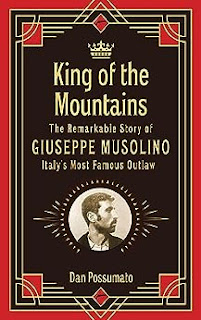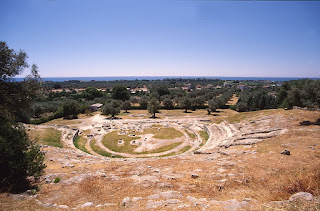Giorgio Chinaglia - footballer
Centre-forward from Carrara became a star on two continents
The footballer Giorgio Chinaglia, who would start his career in Wales before enjoying stardom in his native Italy and then the United States, was born on this day in 1947 in Carrara in Tuscany. A powerful centre forward and a prolific goalscorer, Chinaglia scored more than 100 goals for Lazio. His 193 for New York Cosmos made him the all-time leading goalscorer in the North American Soccer League. Chinaglia left Italy at the age of nine after his father, Mario, decided that his family would enjoy a more prosperous future abroad given the state of Italy's economy in the immediate wake of the Second World War. Jobs at a Cardiff steelworks were advertised in the employment office in Carrara and Mario successfully applied. He would eventually leave the steelworks to train as a chef, building on his experience as a cook in the army, and ultimately opened his own restaurant. The catholic schools Chinaglia attended tended to favour rugby as their principal winter game and his teachers saw in him a potential second-row forward. But rugby was an alien game to him and he much preferred football. Ultimately he was picked for Cardiff Schools, for whom he scored a hat-trick in an English Schools Shield match, in doing so earning a trial at Swansea Town. Read more…
______________________________________
Farinelli – music’s first superstar
Castrato rated among all-time opera greats
The opera singer Carlo Broschi – better known by his stage name of Farinelli – was born on this day in 1705 in the city of Andria in what is now Apulia. Farinelli was a castrato, a type of classical male singing voice that was enormously popular from the 16th to the 18th century, one which had an enormous range and flexibility, a little like a female soprano but subtly different. It was achieved through the somewhat barbaric practice of castrating a male singer before puberty, which is why there are no castrati today. Among other things, the procedure caused changes in the development of the larynx, meaning the voice effectively never breaks, and of the bones, including the ribs, which grew longer than in non-castrated boys and gave the castrato singer considerably enhanced lung power and capacity. Although many survived and, like Farinelli, went on to enjoy a normal lifespan, the practice was hugely risky and there were many deaths not only from post-operative infections but from overdoses of opium or other narcotic drugs administered as painkillers, or else from the compression of the carotid artery in the neck employed as a means of rendering the boy unconscious. Read more…
___________________________________
Assassination of Caligula
Controversial emperor killed by Praetorian Guard
Gaius Julius Caesar Germanicus, the Roman emperor usually referred to by his childhood nickname, Caligula, was assassinated at the imperial palace on the Palatine Hill in Rome on this day in 41AD. His killers were officers of the Praetorian Guard who confronted him in an underground corridor at the imperial palace, where he had been hosting the Palatine Games, an entertainment event comprising sport and dramatic plays. According to one account, Caligula was stabbed 30 times in a deliberate act of symbolism, that being the number of knife wounds some believe were inflicted on Julius Caesar, his great-great-grandfather after whom he was named, when he was murdered in 44BC, although the number of blows Caesar suffered is disputed. Most accounts agree that the chief plotter in Caligula’s murder, and the first to draw blood, was Cassius Chaerea, an officer Caligula was said to have frequently taunted for his weak, effeminate voice. The motives behind the assassination were much more than one aggrieved officer wishing to avenge a personal slight. A descendent of Rome's most distinguished family, the Julio Claudiens, Caligula had initially been popular. Read more…
______________________________________
Galeazzo Maria Sforza - Duke of Milan
Galeazzo Maria Sforza, who became the second member of the Sforza family to take the title Duke of Milan, was born on this day in 1444 in Fermo, in what is now the Marche region. Sforza was an effective ruler but is often remembered as a tyrant with a cruel streak. He ruled Milan for just 10 years before he was assassinated in 1476. In that time, Galeazzo did much to boost the economy of Milan and the wider area of Lombardia. He introduced measures to promote and protect the work of Lombard craftsmen and boosted agriculture by the introduction of jasmine farming and rice cultivation. Farsightedly, he realised that a healthy population was a more productive one and expanded the health institutions started by his father, Francesco Sforza. He minted a new silver coin, the Testone, which carried an image of his profile on the reverse. He saw to it that work on Milan’s cathedral, which had started almost 100 years earlier, continued to progress, and took over the construction of a major hospital that his father had wanted to see built. Galeazzo was also a major patron of music, attracting composers and musicians not just in Italy but from northern Europe. Read more…
_____________________________________
Davide Valsecchi - racing driver and TV presenter
Double GP2 champion’s track career ended in frustration
Davide Valsecchi, now a TV commentator but in his racing days rated as one of the best drivers never to be given a chance in Formula One, was born on this day in 1987 in Eupilio, a small town in the lake district of northern Italy. Valsecchi was twice a champion in GP2, the category just below F1, but despite stints as a test driver and reserve driver for Lotus on the main Grand Prix circuit was never given a chance to compete at the top level. Frustrated because he thought he deserved an opportunity, Valsecchi quit the sport but soon forged a career in television coverage of F1, first as an analyst and then as a commentator, becoming a popular figure with viewers for his excitable style. He also co-presents the Italian version of the hit British car show, Top Gear. Valsecchi made his debut in the Formula Renault and Formula 3 classes as young as 16, making his Formula 3 debut the same year, although it was not until 2007, having stepped up to Formula Renault 3500, that he celebrated his first race victory. That came at the Nürburgring in Germany, where he won the second of the two rounds on the same weekend. The other was won by a future four-times F1 world champion, Sebastian Vettel. Read more…
______________________________________
Arnoldo Foà – actor
Talented performer, director and writer worked into his 90s.
Theatre and film actor Arnoldo Foà was born on this day in 1916 in Ferrara. He began acting in the 1930s and was still appearing on stage after the year 2000 when he was over 90. He had parts in more than 100 films between 1938 and 2007. Foà was born into a Jewish family living in Ferrara but moved with his family to live in Florence when he was three years old, eventually attending an acting school there. He abandoned his economics and commerce studies in Florence at the age of 20 to move to Rome and attend the Centro Sperimentale di Cinematografia. Foà began appearing on stage in the 1930s but his situation became difficult during the war. In order to earn money he had to stand in for actors when they were ill using a false name. He eventually moved to Naples and when the Allies arrived worked for their radio station as an announcer. At the end of the war Foà was able to work in the theatre under his own name again. In the 1950s he started writing, became a theatre director and helped with the development of RAI. During his film career Foà worked for many famous directors. On his website he lists as two of his most prestigious films Il processo (The Trial) directed by Orson Welles and Gente di Roma (People of Rome) directed by Ettore Scola, for which he received an award. Read more…
____________________________________
Book of the Day: Arrivederci Swansea: The Giorgio Chinaglia Story, by Mario Risoli
As a young striker with Third Division club Swansea Town in the ’60s, Giorgio Chinaglia stole milk bottles from the doorsteps of local terraced houses because he couldn’t afford breakfast. Nine years later, as Lazio’s star centre-forward, Chinaglia owned apartments in Rome, a villa, a tennis club and a boat. With an annual salary of £85,000, this son of a Cardiff restaurateur was one of the world’s highest-paid footballers. Arrivederci Swansea is the remarkable rags to riches tale of one of football's original 'bad boys'. Chinaglia was given a free transfer by Swansea in 1966 because the coaching staff considered him too lazy and disliked his attitude. Chinaglia returned to his native Italy to rebuild his ailing career. He joined Roman side Lazio in 1969. There, in the awesome Olympic Stadium, Chinaglia became the idol of the Lazio tifosi. In 1974, he finished as Serie A top scorer with 24 goals and helped Lazio to their first league title. He also played for Italy in the 1974 World Cup and, on being substituted, caused outrage by making gestures at the Italian bench before storming off the pitch. After Lazio he played alongside Pelé and Franz Beckenbauer at New York Cosmos. After retiring from playing, Chinaglia became a football pundit on Italian television and radio until his death from a heart attack on 1 April 2012.Mario Risoli is a journalist and author living and working in Wales. His first book, When Pelé Broke Our Hearts, made the Sunday Times bestseller list. His other books include a biography of John Charles and From Tashkent with Love: Cardiff City and the Cup Winners' Cup 1964-1993.
Home
.jpg)

.jpg)
.jpg)
.jpg)
.jpg)

.jpg)
.jpg)
.jpeg.jpeg)



.jpg)



.jpg)


.jpg)



